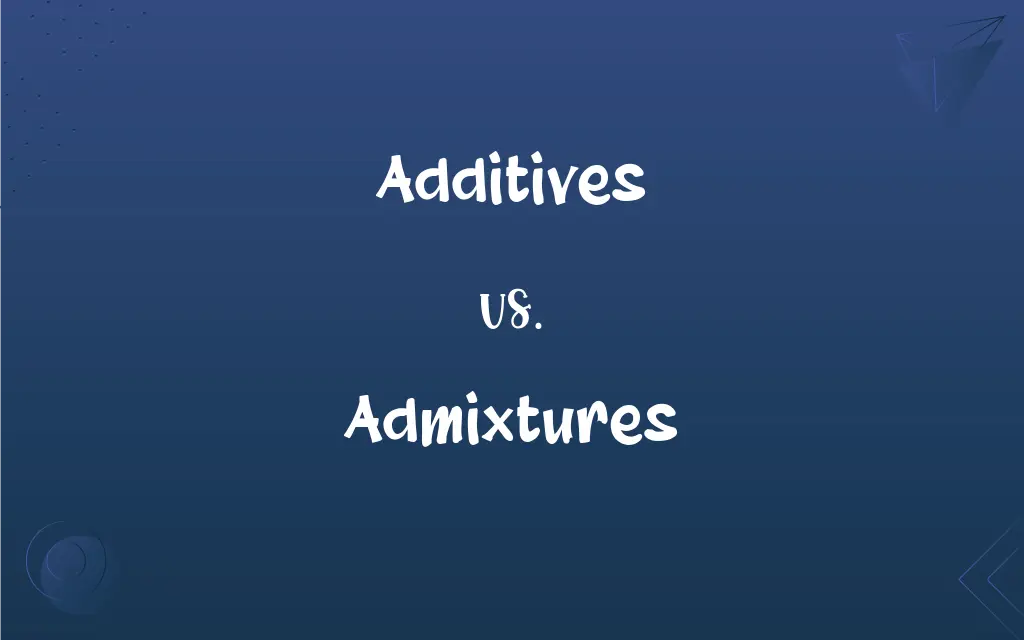Additives vs. Admixtures: What's the Difference?
Edited by Aimie Carlson || By Harlon Moss || Updated on October 14, 2023
Additives are substances added to food to enhance its flavor, appearance, or preserve it; admixtures are materials added to concrete mix to modify its properties.

Key Differences
Additives are typically substances incorporated into food to preserve flavor, enhance taste, or improve its appearance. In contrast, admixtures refer to components, often chemicals, that are introduced into concrete during the mixing process to alter its physical and chemical properties.
Additives, broadly used in various industries, have the primary function of enhancing and preserving product quality. Admixtures, conversely, are predominantly used in the construction industry, aiming to modify the concrete's characteristics, making it suitable for specific applications.
Additives in food might include a range of substances like preservatives, antioxidants, and flavor enhancers. Whereas admixtures in construction can include accelerators, retarders, plasticizers, and superplasticizers, each having a distinct role in manipulating concrete properties.
Within the realm of additives, their use might be governed by regulations, ensuring they are safe for consumption. In the sphere of admixtures, the emphasis might be placed on ensuring that the alterations in concrete properties comply with structural and durability requirements of constructions.
Food additives often come under scrutiny for their potential impacts on human health and are thus regulated. Admixtures, while not ingested, are crucial for structural integrity and durability, impacting the long-term stability and safety of built structures.
ADVERTISEMENT
Comparison Chart
Acronym Meaning
Not applicable
Not applicable
Length
9 letters
10 letters
First Letter
A (Vowel)
A (Vowel)
Vowel Presence
Yes (A, I, E)
Yes (A, I, U, E)
Word Count
1 word
1 word
ADVERTISEMENT
Additives and Admixtures Definitions
Additives
Additives in fuel can improve engine performance.
The fuel additives were designed to clean and protect the engine.
Admixtures
Admixtures can enhance concrete’s resistance to environmental impacts.
Admixtures were utilized to increase the concrete’s resistance to freeze-thaw cycles.
Additives
Additives can be natural or synthetic substances.
Natural color additives are derived from fruits and vegetables.
Admixtures
Admixtures are substances added to concrete to modify its properties.
Admixtures were used to expedite the setting time of the concrete.
Additives
Additives are substances added to food to enhance its properties.
The ice cream contained additives to maintain its vibrant color.
Admixtures
Admixtures may alter the color of concrete for aesthetic purposes.
The contractor used admixtures to achieve a rich, terracotta-colored concrete.
Additives
Additives can act as preservatives, prolonging product shelf life.
Certain additives are incorporated into canned goods to prevent spoilage.
Admixtures
Admixtures might retard the setting of concrete in hot weather.
In the summer, retarding admixtures allow for longer workability periods.
Additives
Additives may enhance or modify the flavor of food products.
The company used additives to sweeten the beverage without adding sugar.
Admixtures
Admixtures can enhance the workability of concrete.
To ease the pouring process, admixtures improved the concrete’s flow.
Additives
A substance added in small amounts to something else to improve, strengthen, or otherwise alter it.
Admixtures
The act of mixing or mingling
The researcher's admixture of different chemicals.
Additives
Marked by, produced by, or involving addition.
Admixtures
The state of being mingled or mixed
The narrative's admixture of fact and imagination.
Additives
Of or being any of certain primary colors of wavelengths that may be mixed with one another to produce other colors. See Table at color.
Admixtures
Something that is produced by mixing; a mixture
An admixture of vitamins and minerals.
Additives
Plural of additive
Admixtures
Something added in making a mixture
Using fly ash as an admixture in making concrete.
Admixtures
Plural of admixture
FAQs
Can additives be natural or artificial?
Yes, additives can be natural, derived from plants or animals, or artificial, created synthetically.
Are all food additives safe for consumption?
Generally, additives used in foods are deemed safe within recommended levels, but regulations can vary by country.
What is the primary purpose of admixtures in construction?
Admixtures are used to modify the properties of concrete, enhancing its workability, durability, and other characteristics.
Can additives be found in organic food products?
Yes, certain additives may be used in organic products, but they typically must meet specific organic certification criteria.
Is it compulsory to use admixtures in all concrete mixes?
No, admixtures are used based on the specific requirements and properties needed for the concrete application.
Can admixtures influence the color of concrete?
Yes, color admixtures can be added to concrete to achieve a desired hue or aesthetic effect.
Are admixtures only used for enhancing the strength of concrete?
No, admixtures can alter various properties of concrete, not limited to strength, such as setting time and workability.
Can the excessive use of additives have potential health impacts?
Yes, excessive consumption of certain additives, like preservatives or artificial sweeteners, might have health implications.
Do all countries have the same regulations for food additives?
No, regulations regarding food additives can vary significantly from one country to another.
Can I avoid additives in my diet completely?
It's challenging to avoid all additives but opting for fresh, whole foods and checking labels can minimize intake.
Are additives only used in food products?
No, additives can be used in various products, including food, fuel, and cosmetics, for different purposes.
Do admixtures impact the cost of concrete production?
Yes, utilizing admixtures can influence cost due to the modified processes or materials but may offer cost efficiencies in other aspects of construction.
How do admixtures affect the curing time of concrete?
Admixtures can either accelerate or retard the curing time of concrete, depending on the specific admixture used and desired outcome.
What is an example of an artificial food additive?
A common artificial food additive is aspartame, a low-calorie sweetener.
Are admixtures available in different forms?
Yes, admixtures are available in various forms, such as liquids, powders, or granules, depending on the application.
What are additives commonly used for?
Additives are often used to enhance flavor, color, or prolong the shelf life of food.
Can admixtures be utilized in both precast and onsite concrete applications?
Yes, admixtures can be used in both precast concrete production and onsite concrete mixing to modify properties as needed.
How are food additives regulated in the USA?
In the USA, food additives are regulated by the FDA (Food and Drug Administration) to ensure safety.
Are all admixtures chemical in nature?
While many admixtures are chemical formulations, some, like aggregates or pigments, are not.
Can admixtures mitigate environmental impacts on concrete?
Yes, certain admixtures are designed to enhance the concrete’s resistance to various environmental factors like freeze-thaw cycles.
About Author
Written by
Harlon MossHarlon is a seasoned quality moderator and accomplished content writer for Difference Wiki. An alumnus of the prestigious University of California, he earned his degree in Computer Science. Leveraging his academic background, Harlon brings a meticulous and informed perspective to his work, ensuring content accuracy and excellence.
Edited by
Aimie CarlsonAimie Carlson, holding a master's degree in English literature, is a fervent English language enthusiast. She lends her writing talents to Difference Wiki, a prominent website that specializes in comparisons, offering readers insightful analyses that both captivate and inform.































































